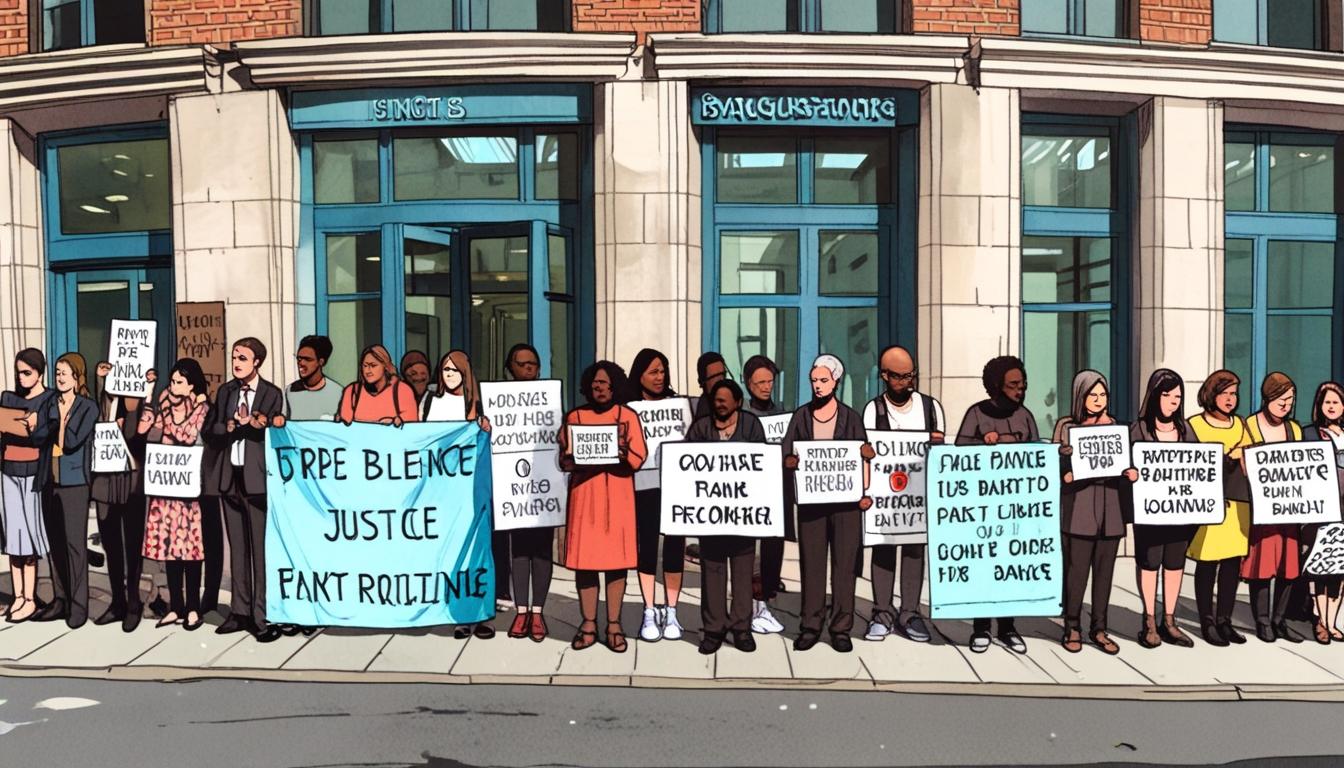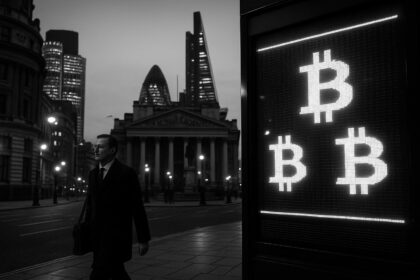At its 2025 AGM, Barclays Bank confronted multifaceted protests from Christian Climate Action and pro-Palestinian groups demanding urgent shifts away from fossil fuel investments and highlighting the bank’s controversial ties, while scepticism grows over its sustainability pledges amid leadership departures.
On 7th May 2025, Barclays Bank’s Annual General Meeting (AGM) at the QEII Conference Centre became a focal point for multifaceted protests aimed at challenging the bank’s investment policies and calling for a shift towards sustainability. Outside, activists engaged in prayerful demonstrations, reflecting a growing concern over the financial sector’s role in exacerbating climate change. This effort was spearheaded by Christian Climate Action (CCA) groups who gathered not only in London but also in various cities across the UK, promoting messages of climate justice alongside their local vigils.
Barclays stands out as the largest funder of fossil fuels in Europe, a position that has drawn significant scrutiny. According to reports, the bank has invested over £75 billion into companies involved in extensive fossil fuel projects, leading many activists to label it a critical player in perpetuating environmental collapse. The protests were not merely local actions; they formed part of a larger narrative where financial institutions are increasingly held accountable for their climate impact.
Vigil participants in places like Loughborough and Truro engaged in contemplative prayer while sharing flyers urging the public to consider more ethical banking options. In Bristol, a group of around 15 activists gathered outside a Barclays branch, advocating for an immediate withdrawal from fossil fuel investments. Their efforts included handing over a letter to the bank’s manager, who indicated that it would be forwarded to corporate headquarters, underscoring a tangible attempt to dialogue with the institution over its practices.
Simultaneously, the AGM in London was disrupted by a group of pro-Palestinian activists who accused Barclays of having financial ties to Israeli defence companies. Their protests highlighted the growing intersectionality of activism within the climate movement, illustrating how social justice issues intertwine with calls for environmental responsibility. These disruptions are part of a broader trend, as other banks such as HSBC have also faced similar protests, prompting discussions around the merits of virtual AGMs to mitigate such dissent.
Barclays, while stating that it merely facilitates trading in arms shares for clients, has faced criticism for its claims of commitment to human rights—particularly in light of its substantial financing directed towards the oil and gas sectors. The recent resignation of Laura Barlow, the bank’s sustainability chief, has led to questions regarding the seriousness of its climate commitments. Under her leadership, Barclays had pledged to mobilise $1 trillion for sustainable financing by 2030. However, many remain sceptical, especially after revelations that in 2022 alone, Barclays allocated a staggering $902 million to fracking companies.
The recent trend towards sustainability-linked loans (SLLs) has also drawn scrutiny. Major companies such as Shell have received billions through SLLs that promise environmental improvements without stringent accountability measures. This lack of rigour can lead to these financial instruments serving more as tools for greenwashing than for meaningful change. Activists fear that without more robust safeguards, banks like Barclays will continue to support industries that are major environmental polluters, undermining genuine efforts to combat climate change.
As global awareness grows regarding both climate change and social injustices, financial institutions are feeling the heat from increasingly organised activist groups. Barclays, forced into the spotlight, faces mounting pressures to shift its investment strategies. The contrasting narratives of activists calling for urgent change and corporate claims of responsibility illustrate the intensity of the climate emergency and the challenges faced by one of the UK’s most influential banks in reconciling profit with sustainability.
The participation of diverse groups in demonstrations indicates a significant moment in activist strategies, where calls for environmental justice are intertwined with broader social movements. As protests continue to shape public discourse, only time will tell how financial policies within major banks will adapt to meet the urgent demands of climate and social justice advocates.
Reference Map
- Paragraphs 1, 2, 3, 4
- Paragraphs 4, 5
- Paragraph 5
- Paragraph 5
- Paragraph 5
- Paragraphs 4, 5
- Paragraphs 4, 5
Source: Noah Wire Services
- https://christianclimateaction.org/2025/05/10/prayerful-protests-across-the-uk-during-barclays-agm/ – Please view link – unable to able to access data
- https://www.ft.com/content/66ee5f27-89f2-45fb-85fa-3cce0759eec8 – Barclays’ 2025 Annual General Meeting (AGM) in London was disrupted by pro-Palestinian protesters who bypassed strict security to protest the bank’s alleged financial ties with Israeli defense activities. Around a dozen activists interrupted the meeting multiple times within the first ten minutes, waving Palestinian flags and accusing the bank of ‘funding genocide.’ They were removed by security shortly after. The protest reflects ongoing activist anger over Barclays’ connections to companies supplying arms to the Israel Defense Forces and its role in aiding Israeli government debt sales. The event followed similar disruptions at other UK banks like HSBC, which has considered switching to virtual AGMs to prevent such interference. Ironically, Barclays removed virtual access to its 2025 AGM despite growing disruptions at in-person events. The UK government is expected to clarify regulations on online AGMs amid increasing corporate interest. Outside the Barclays AGM venue, additional anti-Israel demonstrations occurred, adding to the tense atmosphere. Barclays has stated it merely trades defense company shares for clients and does not invest directly. Chairman Nigel Higgins emphasized the bank’s commitment to human rights and compliance with international guidelines in response to shareholder concerns.
- https://www.reuters.com/business/finance/barclays-sustainability-chief-exits-latest-bank-reshuffle-2025-01-13/ – Barclays’ group head of sustainability, Laura Barlow, has stepped down to pursue other opportunities, amidst a broader reshuffle in senior positions at major banks under increased scrutiny for their climate efforts. Her departure comes after HSBC’s sustainability chief exited following changes that downgraded the role’s significance, raising concerns over the bank’s climate commitments. Barlow, who will remain a senior advisor despite pursuing a portfolio career, led Barclays’ efforts towards sustainability and reducing fossil fuel financing. Daniel Hanna has been appointed as the group head of sustainable and transition finance in her stead. Barclays, criticized for its fossil fuel industry ties, pledged to facilitate $1 trillion in sustainable financing by 2030. Despite the backlash from some U.S. politicians, Barclays remains focused on growing its presence in the U.S. market, particularly in commercial banking, having derived 31% of its revenue from the U.S. in 2023.
- https://apnews.com/article/a28e03c7421222c58025b31ab8185272 – Mega-polluting companies like Shell, Enbridge, and Drax have obtained billions in ‘sustainability-linked loans’ (SLLs) from major banks, promising to improve their environmental practices. However, these loans lack strict accountability, as companies need not use the funds directly for sustainability projects. An investigation revealed that from 2018 to 2023, over $286 billion in SLLs were issued to industries known for environmental damage, including fossil fuels, mining, and deforestation. Companies receiving these loans often publicize vague sustainability goals without binding targets, and some even expand their polluting activities using the funds. Critics argue that SLLs facilitate greenwashing, allowing banks and companies to enhance their reputations without making substantial environmental improvements. For example, despite receiving SLLs, Drax and Enbridge expanded operations that significantly increase carbon emissions. Proponents claim these loans promote broad environmental improvements, but evidence suggests they often fail to produce meaningful change and may instead perpetuate environmentally harmful practices.
- https://www.ft.com/content/007958bb-256a-4380-82e2-a917e4ebe3b8 – The International Energy Agency (IEA) has subtly altered its language on fossil fuel investments, potentially creating significant implications for the financial sector. In 2021, the IEA stated there was no need for new fossil fuel supply investments. However, in a 2023 update, it mentioned that no new ‘conventional long-lead-time oil and gas projects’ should be approved after 2023, without defining these terms. This vague language has been exploited by Barclays Bank, which, while restricting financing for ‘long-lead expansion’ projects, could still finance other expansions like fracking. In 2022, Barclays provided $902 million to fracking companies, constituting 80% of its financing for pure oil and gas firms. Although Barclays has imposed stricter climate policies than some peers, it remains a major financier of fracking in the US. The non-profit ShareAction criticizes this loophole and urges Barclays to eliminate financing for all oil and gas-focused companies. Additionally, new data shows emissions in the EU’s Emissions Trading System dropped by 15.6% in 2022, with only Sweden recording an increase due to domestic aviation.
- https://www.theguardian.com/business/2023/may/03/climate-protesters-rework-spice-girls-song-to-disrupt-barclays-agm-london – Barclays’ annual general meeting was disrupted by climate activists deploying Shakespeare-inspired quotes and reworked lyrics of a Spice Girls hit to condemn the bank’s role as one of Europe’s largest funders of fossil fuels. Dozens of activists from groups including Fossil Free London and Extinction Rebellion UK began their action less than five minutes into the meeting where its chair, Nigel Higgins, was addressing shareholders at the QEII Centre in Westminster, central London. A choir was the first to interrupt, with a rendition of the Spice Girls song Stop. Reworking the 90s classic’s lyrics, the group sang: ‘Stop right now, no more oil and gas, stop burning fossil fuels and end this madness … hey you, burning up the Earth, gotta stop it now baby we have had enough … you dirty, dirty bank.’
- https://news.sky.com/story/climate-protesters-use-spice-girls-and-shakespeare-to-disrupt-barclays-agm-12872016 – Environmental activists from Extinction Rebellion, Fossil Free London and Climate Choir were protesting the UK high street bank’s investment in new fossil fuel projects despite heavy security at the AGM venue. The first interruption came as dozens of protesters broke out in song with a variant of the Spice Girl’s Stop with lyrics changed. ‘Stop right now, no more oil and gas. Stop burning fossil fuels and end this madness.’
Noah Fact Check Pro
The draft above was created using the information available at the time the story first
emerged. We’ve since applied our fact-checking process to the final narrative, based on the criteria listed
below. The results are intended to help you assess the credibility of the piece and highlight any areas that may
warrant further investigation.
Freshness check
Score:
9
Notes:
The narrative references the Barclays AGM held on 7th May 2025 and mentions a very recent resignation of Laura Barlow as sustainability chief, indicating very current information. There are no signs of recycled or outdated news. No press release format is apparent, which supports a high freshness rating.
Quotes check
Score:
8
Notes:
No direct verbatim quotes attributed to individuals were found in the narrative, only paraphrased statements and references to actions by activists and Barclays representatives. Thus, early online references to direct quotes are not applicable. This suggests original reporting or unique content rather than reusing old quotes.
Source reliability
Score:
5
Notes:
The narrative originates from christianclimateaction.org, which is an activist organisation’s site rather than a mainstream reputable news outlet. While it provides firsthand reporting on activism events, its perspective is advocacy-driven, lacking the editorial independence and widespread verification typical of established media such as BBC or Reuters.
Plausability check
Score:
9
Notes:
The claims regarding Barclays as a major fossil fuel funder, recent protests, and the resignation of the sustainability chief align with known ongoing trends and reported events up to 2025. The context of climate-focused activism intersecting with financial institutions is plausible and consistent with current environmental and social justice movements. The lack of contradictory information bolsters plausibility.
Overall assessment
Verdict (FAIL, OPEN, PASS): PASS
Confidence (LOW, MEDIUM, HIGH): MEDIUM
Summary:
The narrative presents fresh and plausible information concerning recent protests at Barclays’ 2025 AGM and related climate activism. While no direct quotes are present to verify, the content appears original and timely. The main limitation is the moderate reliability due to its origin from an activist organisation rather than an established independent news outlet. Overall, the report is credible and aligns with known facts and trends.













